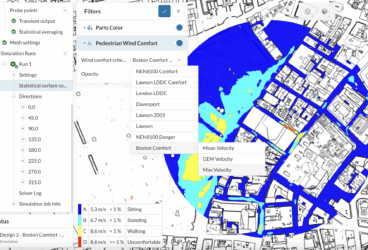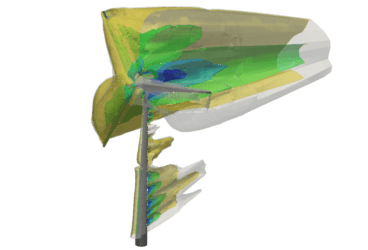As urbanization increases, more and more people live and frequent in bustling city centers. This, in turn, creates a problem with how to create more space, and more specifically a housing problem, where many developers across the globe have begun opting for high-rise buildings. Examples of this can be seen in major cities across Europe such as the Stockholm Royal Seaport project in Sweden, as well as in American cities like New York City, and across Asia in China, Japan, and Singapore.
Wind nuisance, or unfavorable wind conditions, are becoming more important as a factor to consider for both zoning and construction plans, as these new high-rise buildings can create higher wind speeds and stronger gusts at the pedestrian level. Yet, as high wind velocities are innately unpleasant for people, how does one determine the exact point at which it becomes bothersome? As people differ in height and wind tolerance, this becomes a taxing responsibility. Therefore, it’s imperative to assess its impact on pedestrians, or something broadly referred to as ‘pedestrian wind comfort’.
How to Calculate Pedestrian Wind Comfort in a Specific Location
In order to evaluate the pedestrian wind comfort in a particular location for a current or future structure, three elements need to be determined and then combined:
- Historical meteorological data: Close to the location of the building to capture representative/typical wind conditions.
- Local wind conditions: Influenced by the building and its surroundings.
- Specific comfort criteria: Relate local wind speeds to actual subjective “wind comfort” felt by pedestrians.
In order to evaluate the pedestrian comfort, the local wind velocity needs to be related to the weather station data in order to obtain the probability of the local wind speed exceeding the threshold wind speeds defined by the comfort criterion.
Wind Comfort Criteria
There are many criteria and standards existing today to help assess the expected wind climate in the design stage, by providing parameters of what should be achieved to stay within favorable conditions. In this article, we will explore the Lawson, Davenport, and NEN 8100 wind criteria.
These 3 criteria are considered comprehensive or complete, as they address a wide range of activities, including “sitting/standing long”, “sitting short” and “strolling”. All three criteria consist of a threshold value of the wind speed and a maximum allowable exceedance probability of this threshold value.
Download our ‘Wind Engineering’ white paper to learn about building design, wind loading implications, pedestrian wind comfort, natural and mechanical ventilation, pollution mitigation, and more!
This paper addresses the topic of pedestrian wind comfort, from origin and
definition to wind comfort analysis, criteria, and example case studies; all meant to
form an in-depth understanding of the field.
Lawson Criteria
Lawson criteria, named after the researcher T.V Lawson and published in 1978, are a series of comfort criteria categories that quantify the worst wind conditions that most passersby will consider acceptable. Levels of pedestrian comfort strongly depend on individual activity. Therefore, the Lawson comfort criteria are defined for each activity in terms of a threshold wind speed which should not be exceeded for a given time throughout the year.
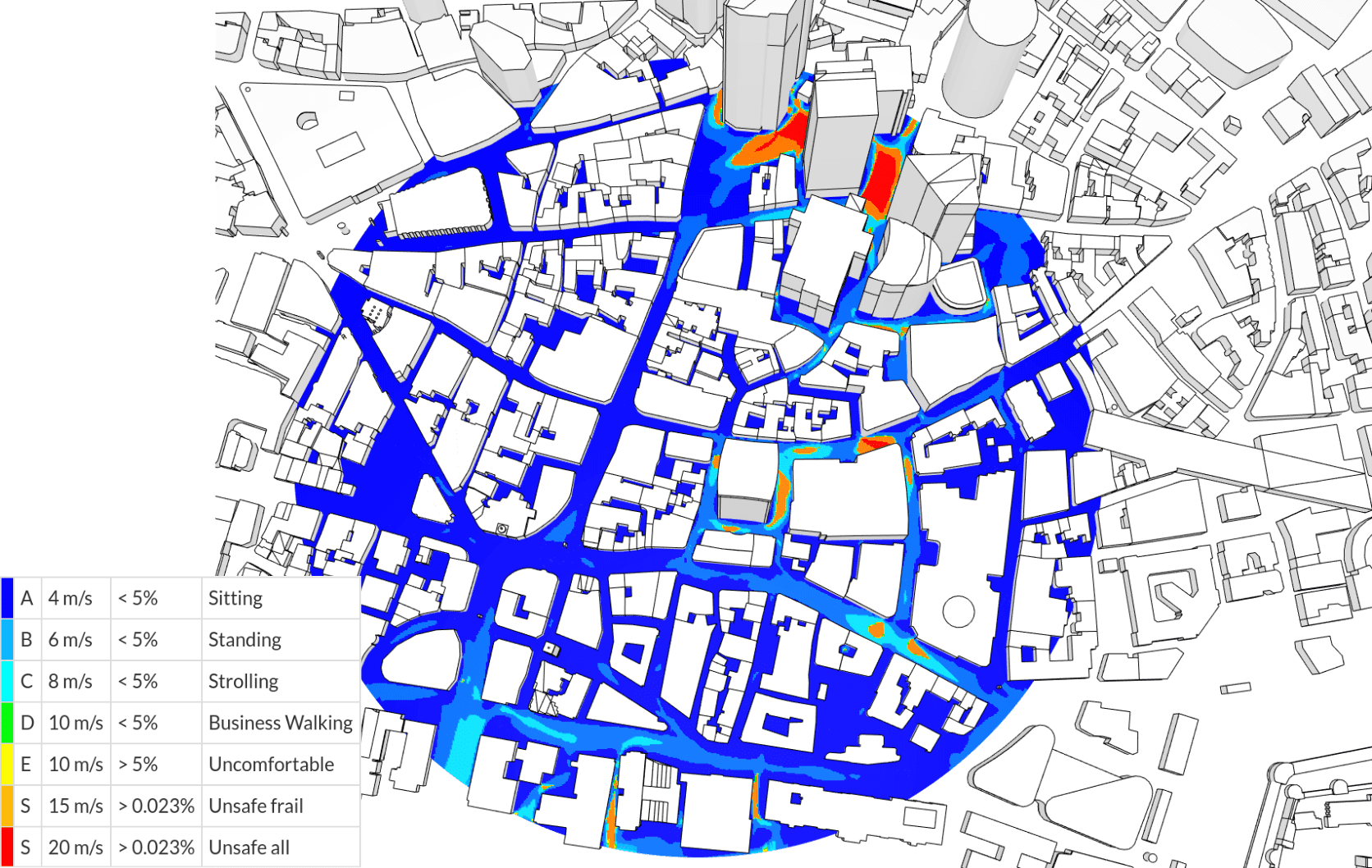
Pedestrian comfort criteria are assessed at 1.5m above ground level. Unless in extremely unusual circumstances, velocities at pedestrian level increase as you go higher from ground level. Therefore an assessment at 1.5m will usually be more onerous than one at, say 0.5m (wind velocity is always zero where it meets the ground). Lawson assumes that wind speeds exceed its average velocity of less than 5% of the time considered.
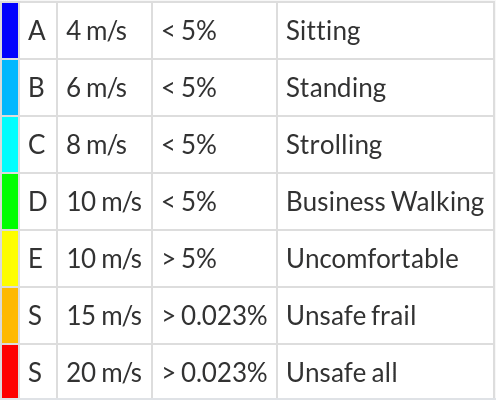
The first group (pictured above) of comfort criteria groups wind speeds according to activities that an individual might reasonably conduct under those conditions. Someone sitting at an outdoor cafe and reading a newspaper will become uncomfortable at much lower wind speeds than someone walking briskly to catch the next bus.
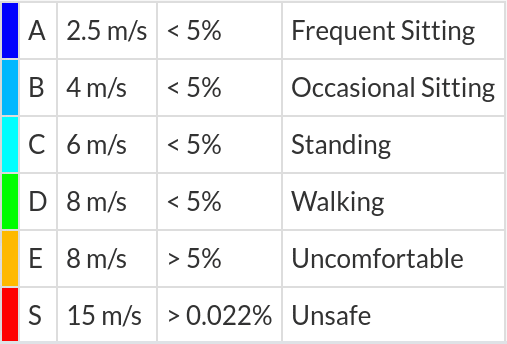
The most famous of the Lawson criteria (pictured above) is the LDDC (London Docklands Development Corporation) method, which specifies a limit of 0.025%, using wind speeds of 20m/s for “General Public”, and 15m/s for “Frail Person Or Cyclist”. Non-adherence to these criteria requires a reconsideration of the design.
Davenport Criteria
The Davenport comfort criteria are the oldest of the group, as it was published in 1975, making it the first of its kind in pedestrian wind comfort standards. The standard applies a maximum exceedance probability of “one/week” for tolerability of wind climate for certain activities. The associated exceedance probability is said to be 1.5%, yet it is slightly unclear how this value was obtained. One hour a week would be 0.6% (1/168×100%), a value also used by Lawson when comparing his comfort criteria with Davenport’s.
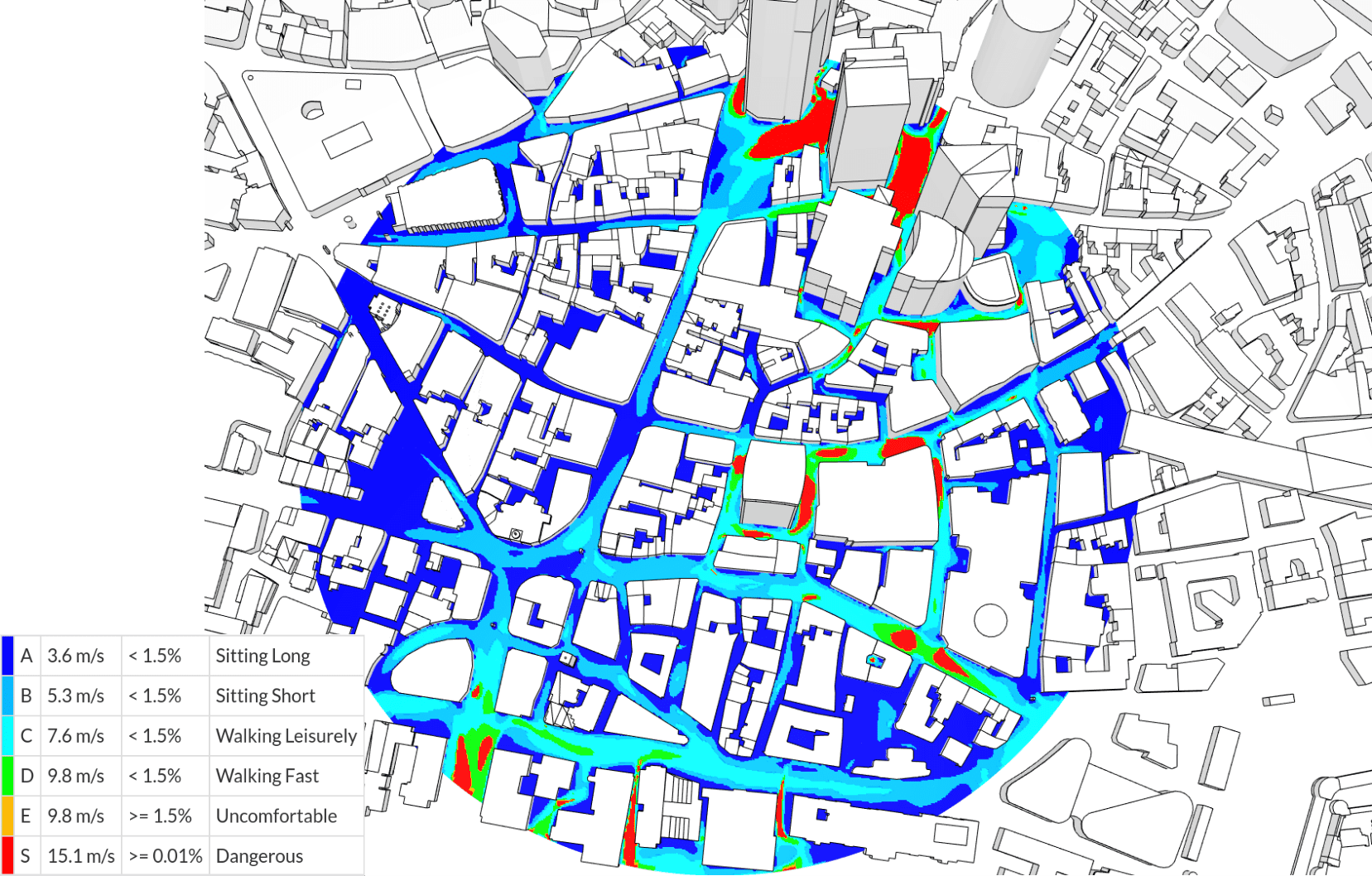
The Davenport criterion also uses the Beaufort scale like the wind speed threshold. However, the Beaufort scale contains an interval of values for wind speed. As a result, the exact value of the wind speed threshold is not clear.
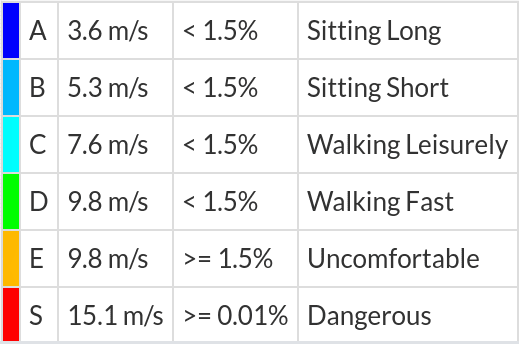
The Davenport criterion is essentially divided into specific activities and evaluates how comfortable it is to practice that activity at a certain location. The longer the average wind speeds exceed this limit, the more uncomfortable the activity is assumed to be.
NEN 8100 Criteria
The most recent of these standards is the Dutch wind nuisance standard (NEN 8100), and it applies a discomfort threshold for the hourly mean wind speed of 5 m/s for all types of activities.
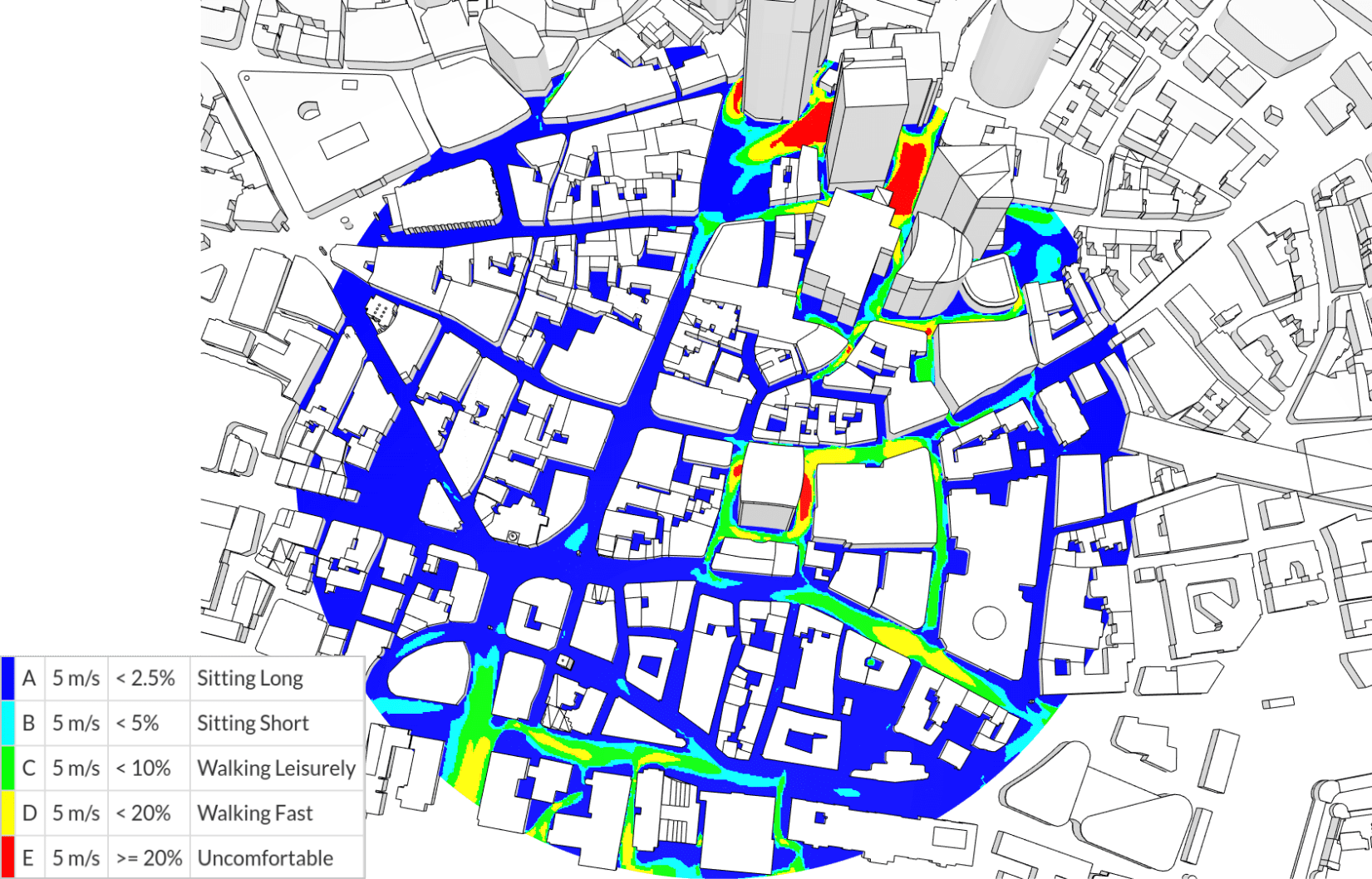
Depending on the exceedance probability of the threshold wind speed, the code defines five quality classes of wind comfort A–E (Table 1). This standard also advises on dangers caused by wind.
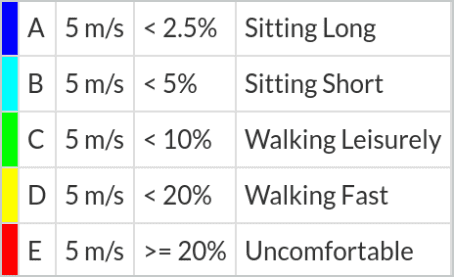
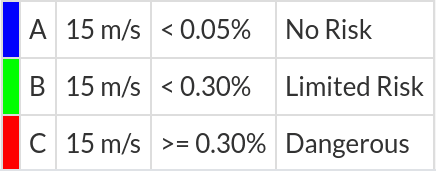
SimScale’s New Wind Comfort Analysis Tool
However, despite standardizations being put in place, they can all lead to very different conclusions about wind comfort. Luckily, SimScale has found a solution to evaluate all of these criteria in parallel. Our multi-directional wind analysis feature greatly improves time to project completion, by supporting up to 36 wind rose-driven directions to be concurrently simulated and automatically calculating the Lawson, Davenport, and NEN 8100 wind comfort criteria. To find out more, check out this article.
Additional Wind Comfort Resources from SimScale
- How to Analyze Pedestrian Wind Comfort with SimScale
- SimScale Feature Release: Multi-Direction Pedestrian Wind Comfort Analysis
- How to Assess Pedestrian Wind Comfort in 2019
- Boston Waterfront Weather & Pedestrian Wind Comfort
- Sustainable Wind Engineering: The Stockholm Royal Seaport Project


